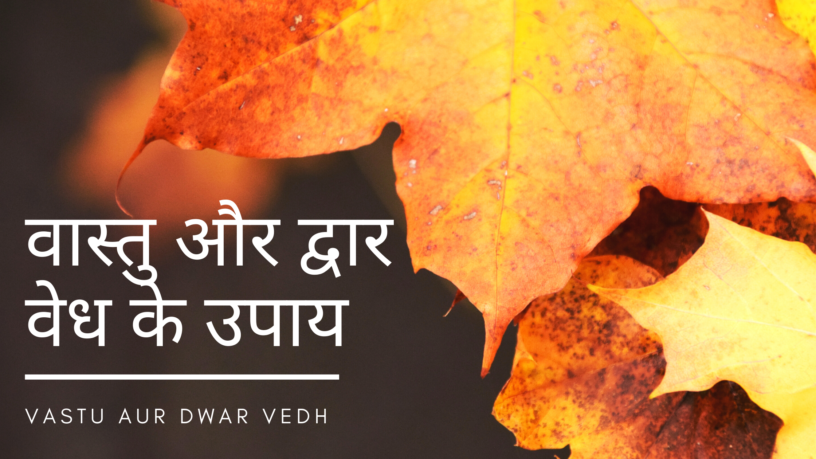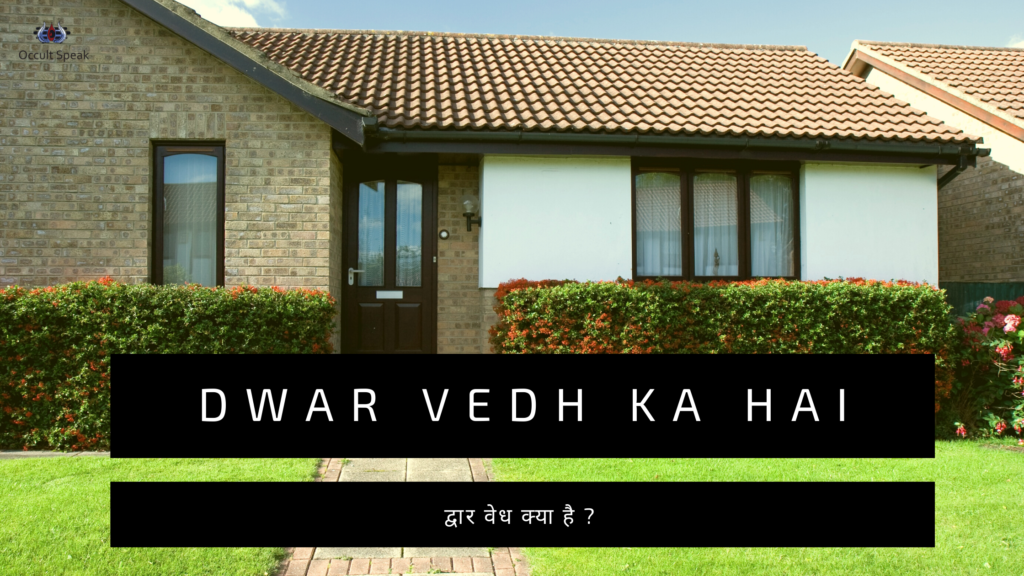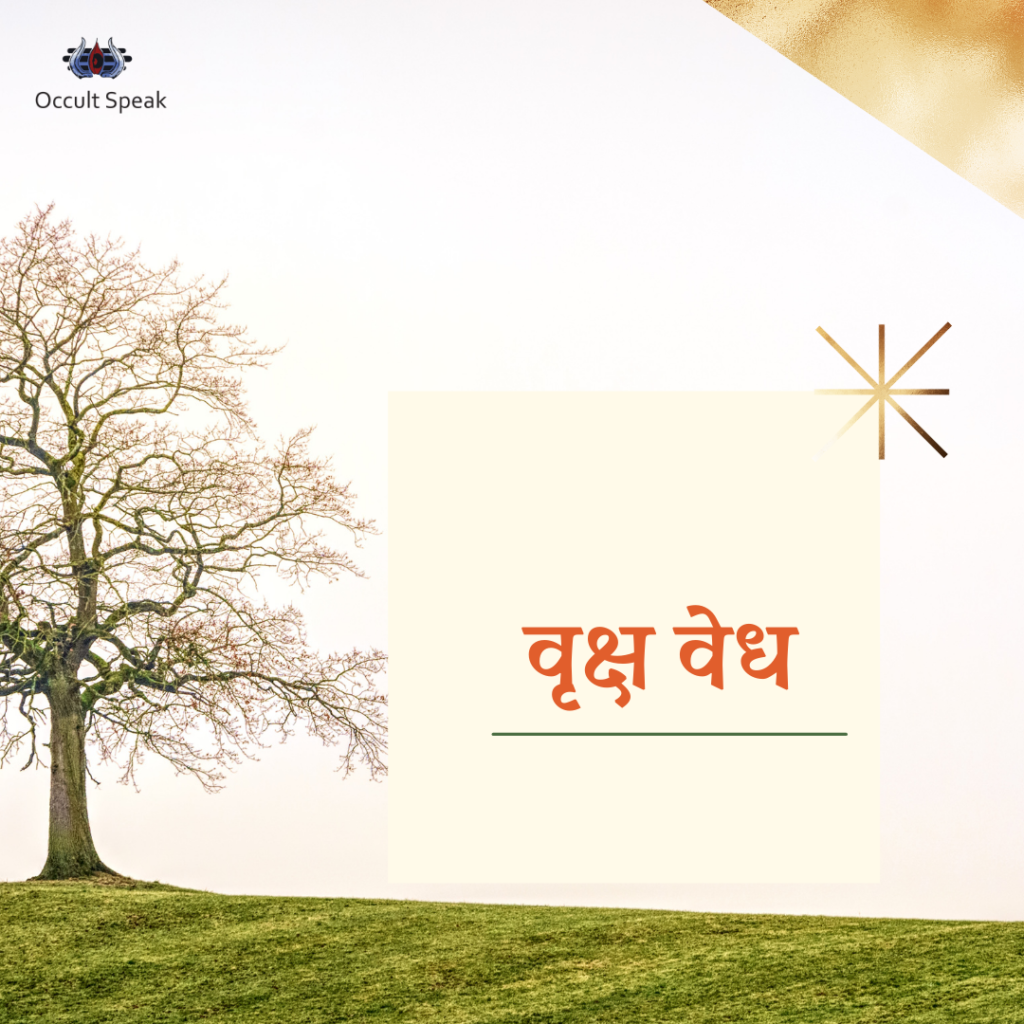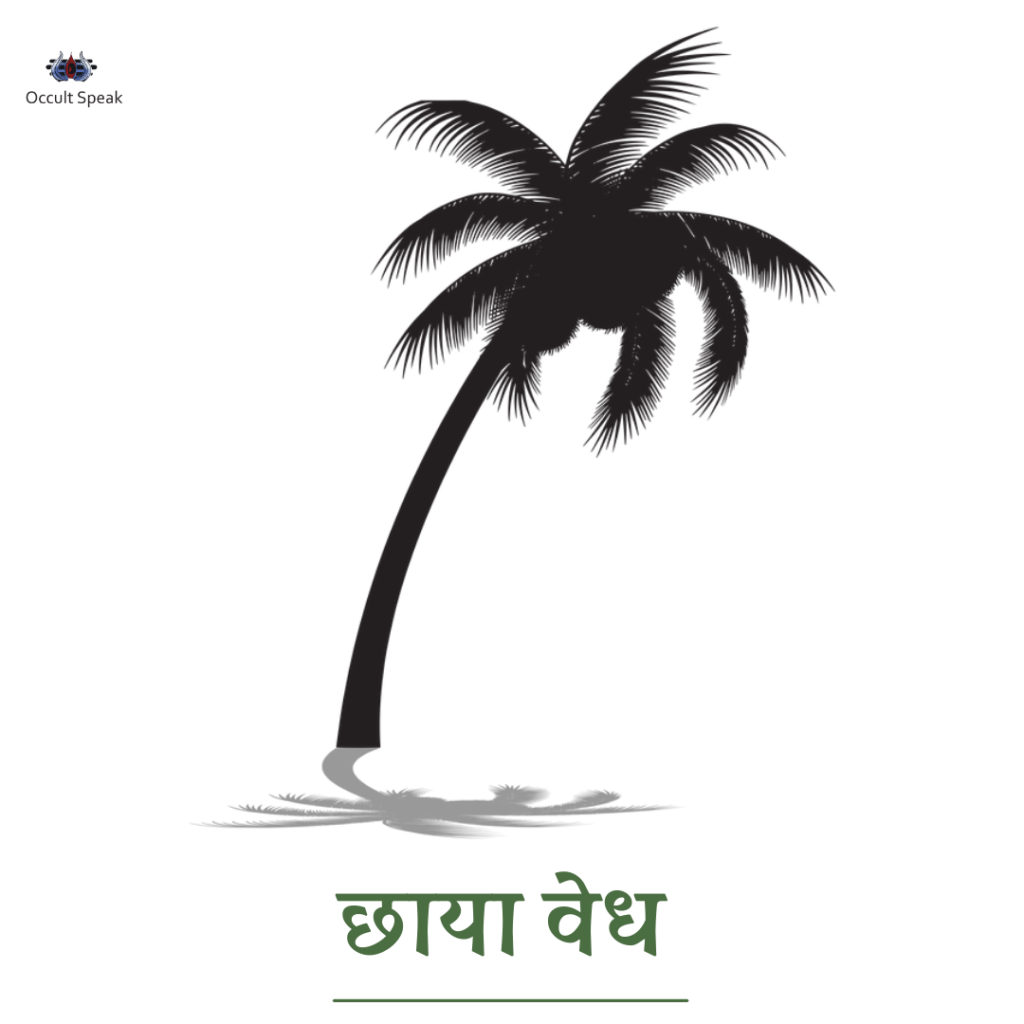Effect of Dwar Vedh (Door obstruction) and Chayaa Vedh on Vastu
Dwar vedha means obstruction in the path of light and air, it means that in a way, the defect which creates obstruction in your Vastu is called ‘door vedha’ or ‘shadow vedh’, in which the sun’s rays and air are opposed.
For this reason, in Indian scriptures and in Indian tradition, it has been called in the name of Dosha i.e. Dwar Veda in the architecture of India.
The meaning of obstruction(vedh) is not related to the parts of the building, but small places near the building.
A common obstruction in Vastu Shastra can also be found from classification.
This word is vedh mean obstruction i.e. it has many types, such as tal vedh, kope vedh, kala vedh, lalu vedh, pillar vedh, tula vedh and door vedh.
In Vastu Shastra, where has the defect created by the entrance of the door (dwar) gone, which is always taboo.
Here I will only say that it is considered very difficult to avoid Dwar obstruction. It should be solved only by removing such obstacles.
The defect or obstruction is eliminated by leaving a recess of twice the height of the building due to the object which is causing the defect in the middle or in the middle, that is, in your Vastu.
The law of Vastu has been unanimously accepted in all the texts that the recess of 2 times the height of the building (that is to say, leaving the door (mukhya dwar) to its obstruction) does not apply to the defect of obstruction.
By the way, there are many types of defects like this type of door obstruction. (dwar vedh).
According to ancient scriptures, 9 types of door obstructions have been considered to be prohibited.
Types of Obstructions (Dwar Vedh) in Vastu
1. Do not make gates in the middle of the house and at the joint place.
2. If the house does not have other storeys, then do not make the door behind the house.
3. In front of any building or main gate, there should not be a chariot, square, well, pond gutter, corner of another house, big tree, pole, animal tying peg, chariot (garage) etc. All these things have been said from the point of view of security.
4. There should not be any mud or running water in front of the door. If water or mud will accumulate in front of the door, it will weaken the foundation of the house and it is considered to be a door obstruction in the scriptures.
5. In front of the entrance of the house, there should not be a peg to tie any kind of animal like cow, goat or any animal, hence it is called nail piercing in the scriptures.
6. If there is any kind of sound while opening or closing any door, then it has been called swara vedh in the scriptures. It is also said to be a kind of impure and inauspicious indicator.
7. In front of the house, a well, a water tank or a pit, here in any way the shadow falls on the house or if the shadow of that house falls on the well, then it has been called well as obstruction in the scriptures.
8. In front of the entrance of the house, if there is a thick or drain of oil grinding or if there is any kind of filth, then it is called an illusion in the scriptures. This obstruction is a sign of calamity.
9. Even if the doors (dwar) of the house are uneven / high and low, the door is called obstruction.
Big wall (Dwar Vedh) just in front of the main entrance of the building.
If there is a compound wall, a large hoarding, or if there is any obstruction, then this faulty “Dwarvedha” is a hindrance in the progress and prosperity of the planet.
The compound wall of the factory is fine, but if the gate (auxiliary door) of the boundary wall is bigger than the main entrance, or is bigger than the boundary wall, then such construction becomes a hindrance in the fortune of the homeowner.
Such small errors destroy the whole industry. That is why the person or businessman should keep in mind that there should be no big door in the ratio of the boundary wall and in front of the main door.
There should not be a wall of another building in front of a private residential building. Such a building stops the progress of the homeowner.
Kon Vedh (Angle Obstruction):
If the corner of another building is right in front of the entrance of another building, then it is also called Vastu Dosh.
The person living in it does not get the fruits of their labour. This is mainly called angle valid. There should not be an obstruction from the corner of the second house at the entrance.
Chaaya Vedh (Shadow Obstruction)
These are of 4 types. There should not be a mountain on the east side of the village. At sunrise, the shadow of the mountain should not fall on the village or on the house.
It is considered very good to have a village or to build one’s own house, equal to the shadow of the mountain or outside the shadow of the mountain.
Similarly, the shadow of any kind of big tree near the house should not fall on the house.
Here the farther the tree is from the house, its shadow will not fall on the house. In such a situation, the tree will never in any way fall on your house or cause damage to your house. This too is called Chhaya Veda in the scriptures.
Dev Prasad means that there is always a crowd of citizens in the temple. In the earlier times and on the occasion of special festivals, the crowd of travelers is very high, so it is very important to have open space around the temple.
Never build a house near the temple as far as the shadow of the flag of the temple, which we also call the flag, falls.
Therefore, the former masters and the greatest scientists probably later made this rule, in which the temple and the tree were kept out of the construction work.
Chhaya Vedh (Shadow Obstruction)
It is considered wise to always avoid the inauspicious sight of shadow and that is why this monument should not be a shadow statue of any kind of objects in front of your house or house.
You should also keep in mind that the shadow of your own house should not fall on any well.
Do let me know how you liked this article on Types of Vedh in Vastu Shastra?
Regards,
द्वार वेध और छाया वेध का वास्तु पर प्रभाव
द्वार वेध ( Dwar Vedh ) का तात्पर्य प्रकाश और वायु के मार्ग में रुकावट से है। कहने का मतलब यह है कि यह एक प्रकार से आपके वास्तु में
विघ्न-बाधा उत्पन्न करने वाला जो दोष है, उसको द्वार वेध या छाया वेध कहा जाता है।
इस वास्तु दोष में सूर्य की किरण और वायु का विरोध होने लगता है। इस कारण भारतीय शास्त्रों में और भारतीय परंपरा में इसको दोष अर्थात वेध के नाम से भारत के स्थापत्य में कहा गया है ।
वेध का अर्थ है – रुकावट। तो इसका संबंध भवन के अंगों से नहीं बल्कि भवन के निकट छोटे-छोटे जो स्थान, उन वस्तुओं को रुकावट का नाम देकर हम उन्हें वेध कहते हैं ।
वास्तु शास्त्र में एक सामान्य वेध वर्गीकरण से भी मिलता है। वेध के कई प्रकार होते हैं, जैसे टल वेध, कोप वेध , कला वेध, लालू वेध स्तंभ वेध, तुला वेध और द्वार वेध ।
वास्तु शास्त्र में द्वार वेध द्वारा निर्मित दोष कहा गया है – जो सर्वदा वर्ज्य है । यहां पर मैं इतना ही कहूंगा कि द्वार के वेध से बचना बहुत ही कठिन होता है । इस प्रकार के विघ्न-बाधाओं को दूर हटा कर ही इसका निवारण किया जाना चाहिए । जो वस्तु से बीच में दोष उत्पन्न हो रहा हो या फिर बीच में अर्थात आपके वास्तु के बीच में आ रही हो , उससे भवन की ऊंचाई का दोगुना स्थान छोड़ देने पर ही वह दोष या वेध समाप्त हो सकता है ।
वास्तु का नियम सभी ग्रंथों में एकमत से स्वीकार किया गया है कि भवन की ऊंचाई से 2 गुना स्थान (कहने का तात्पर्य है के द्वार से उसके वेध तक का छोड़ देने) होने से वेध का दोष लागू नहीं होता ।
वैसे तो इस प्रकार के दोष – जैसे की द्वार वेध अनेक प्रकार के होते हैं। प्राचीन शास्त्रकारों ने कूल ९ प्रकार के द्वार वेध निषेध माना है ।
१. घर के मध्य में और संधि स्थान पर द्वार नहीं बनाऐं ।
२. मकान की यदि अन्य मंजिले न हो तो मकान के पीछे दरवाजा नहीं बनाये ।
३. किसी भी भवन या मुख्य द्वार के सामने रथ-मार्ग , चौराहा , कुआँ, तालाब। गटर , दूसरे मकान का कोना , बड़ का पेड़ , खम्बा, जानवर बांधने का खूटा , रथस्थान (गेराज ) आदि नहीं होना चाहिए । यह सब बातें सुरक्षा की दृष्टि से कही गयी हैं ।
४.दरवाज़े के सामने कीचड़ या बहता पानी नहीं होना चाहिए। दरवाज़े के सामने पानी या कीचड़ बढ़ जाएगा तो इससे मकान की नींव कमज़ोर होगी और इसे शास्त्रों में द्वार वेध माना गया है।
५.मकान के प्रवेश द्वार के सामने किसी प्रकार का जानवर जैसे कि गाय, बकरी या कोई भी जानवर को बाँधने की खूंटी नहीं होनी चाहिए इसलिए शास्त्रों में कील वेध कहा गया है।
६.दरवाज़े के किवाड़ खोलते हुए या बंद करते समय यदि किसी प्रकार की आवाज़ होती है तो उसे शास्त्रों में स्वर वेध कहा गया है। यह भी एक प्रकार का अशुद्ध और अशुभ सूचक कहा गया है।
७. मकान के सामने कुआँ, पानी की टंकी या गड्ढा यहाँ किसी भी प्रकार से मकान के ऊपर छाया गिरती हो या फिर उस मकान की छाया कुएँ के ऊपर पड़ती हो तो उसे शास्त्रों में कूप वेध कहा गया है।
८.मकान के प्रवेश द्वार के सामने तेल पीसने की घना या नाला हो या किसी भी प्रकार का गन्दगी हो तो उसे शास्त्रों में भ्रम वेध कहते है । यह वेध विपत्ति का सूचक है ।
९. मकान के दरवाजे ऊँचे-नीचे हों तो भी द्वार वेध कहते हैं।
भवन प्रवेश के मुख्य द्वार के ठीक सामने बड़ी दीवार, कंपाउंड वॉल, बड़ा सा होर्डिंग, या कोई रूकावट हो तो तो यह दोषपूर्ण “द्वार वेध” गृहस्वामी की सम्पन्न होने में और तरक्की करने में बाधा होती है ।
फैक्ट्री की कंपाउंड वॉल तो ठीक पर यदि चारदीवारी का गेट (सहायक दरवाजा) मुख्य प्रवेश द्वार से बड़ा है , या चारदीवारी से बड़ा है तो ऐसा निर्माण गृहस्वामी के भाग्योदय में बाधा बनता है ।
ऐसे छोटी-छोटी त्रुटियां सारे उद्योग को नष्ट कर देती है । इसीलिए जातक या व्यापारी को ध्यान रखना चाहिए की चारदीवारी का दरवाजा के अनुपात में और मुख्य दरवाजा के सामने कोई बड़ा द्वार नहीं होना चाहिए ।
निजी निवास/भवन के सामने अन्य भवन की दीवार नहीं होनी चाहिए । ऐसा भवन गृहस्वामी की प्रगति को रोक देती है ।
कोण वेध Kon Vedh : एक अन्य भवन का कोना, दूसरे भवन के प्रवेश द्वार के ठीक सामने हों तो यह भी वास्तुदोष कहा जाता है। इसमें रहने वाले व्यक्ति को उनके परिश्रम का फल नहीं मिलता। इसे मुख्य रूप से कोण वैध कहते हैं। प्रवेश द्वार के दूसरे मकान के कोने से वेध नहीं होना चाहिए ।
छाया वेध Chayaa Vedh – ये 4 प्रकार के होते हैं। गाँव के पूर्व दिशा की तरफ़ पर्वत नहीं होना चाहिए। सूर्योदय के समय पर्वत की छाया गाँव पर या मकान के ऊपर नहीं पड़नी चाहिए। पर्वत की छाया के बराबर या पर्वत के छाया के बाहर गाँव का होना या अपना मकान का निर्माण करना अति उत्तम माना गया है।
इसी प्रकार से मकान के नजदीक, किसी भी प्रकार के बड़े वृक्ष की छाया मकान के ऊपर नहीं आनी चाहिए। यहाँ वृक्ष मकान से जितना दूर होगा उसकी छाया मकान पर नहीं गिरेगी। ऐसे स्थिति में कभी वृक्ष किसी प्रकार से आपके मकान के ऊपर न छाया गिरेगी या आपके मकान को नुक्सान देगी । इसको भी शास्त्रों में छाया वेद कहते हैं।
देव प्रासाद अर्थात मंदिर में हमेशा नागरिकों की भीड़ रहती है । पूर्व काल में और विशिष्ट त्योहारों के उपलक्ष्य में यात्रियों की भीड़ बहुत ज़्यादा होती है इसलिए मंदिर के चारों ओर खुली जगह होना अति आवश्यक हैं। मंदिर के झंडे जिसको हम ध्वजा भी कहते हैं उसकी छाया जितनी दूर तक पड़ती हो वहाँ तक मंदिर के पास कोई मकान कभी ना निर्माण करें।
इसलिए पूर्व के आचार्यों ने और महानतम वैज्ञानिकों ने संभवत: बाद में यह नियम बनाया इसमें मंदिर और वृक्ष को निर्माण कार्य से बाहर ही रखा ।
छाया वेध Chayaa Vedh : छाया की अशुभ दृष्टि से हमेशा से बचना ही समझदारी माना गया है और इसीलिए अपने मकान या घर के सामने ही किसी भी प्रकार की वस्तुओं की छाया, मूर्ति स्तंभ या स्मारक पर नहीं होनी चाहिए। यह भी आपको ध्यान में रखना चाहिए कि ख़ुद के मकान की छाया किसी कुएँ पर नहीं पड़नी चाहिए क्योंकि यह भी अशुभ सूचक माना गया है।
वृक्ष वेध Vruksha Vedh : मकान के प्रवेश द्वार के सामने बड़ा सा वृक्ष हो तो उसे वृक्ष वेध कहा गया है। जो वृक्ष जितना बड़ा होगा उसकी आयु उतनी ही बड़ी होगी। तो फिर ऐसा वृक्ष यदि किसी मकान पर गिर गया हो तो मकान को भारी नुक़सान होगा ही और साथ घर के आस पास वृक्ष होने पर घर की नीव कमज़ोर हो जाती है और दीवारों में दरारें पड़ जाती है।
विशाल वृक्ष के कारण तरह-तरह के जानवर और पशु-पक्षी और अन्य प्राणी घर में प्रवेश करते हैं। जिससे घर में रहने वाले सभी सदस्यों प्राणी और वस्तुओं को नुक़सान पहुँचने की संभावना रहती है। घर के बिलकुल सामने सीध में सूखा हुआ वृक्ष या ठूठ हो तो वह भी अशुभ माना गया है।
वृक्ष की छाया पर घर पर नहीं पड़नी चाहिए। भवन के बिलकुल सामने या मार्ग के दूसरी तरफ़ यदि कोई डरावना और दो शाखा वाली वृक्षों हो भी यह अशुभ माना गया है।
आँधी-तूफ़ान और वर्षा के समय विशाल वृक्ष भयंकर आवाज़ करते हैं। विशाल वृक्ष बादल को अपनी ओर खींचते हैं। इससे विद्युत् का ख़तरा बना रहता है। इसके फलस्वरूप घर के सदस्य मृत्यु के शिकार बन जाते हैं। इसलिए इस प्रकार का दोष से बचना अति आवश्यक माना गया है।
किसी भी भवन घर फ़ैक्ट्री या कार्यालय में किसी भी प्रकार के वृक्ष की एक प्रहर से अधिक छाया पड़ना शुभ नहीं माना गया है। ऐसे ही एक प्रहर की छाया से स्वयं रहने पर भी अशुभ माना गया है।
मकान के प्रवेश द्वार पर और चारों और वृक्ष को लगाना वृक्ष का दोष माना गया है । जैसे उदुंबर का वृक्ष, पूर्व दिशा में वट- वृक्ष, दक्षिण दिशा में और न्योग्रध वृक्ष, पश्चिम दिशा में कभी नहीं लगाना चाहिए। आपके मकान के समीप फलवाले, दूध वाले वृक्ष और काँटेवाले वृक्ष हमेशा अशुभ मने गए है। ऐसे वृक्ष हमेशा रोग और संशय और समस्या देते है। ऐसे वृक्ष लगाने से हमेशा चोरी होने का भय लगा रहता है ।
आज का यह लेख – द्वार वेध और छाया वेध का वास्तु पर प्रभाव
आपको कैसा लगा ?
,
नीरव हींगु







Leave a Reply